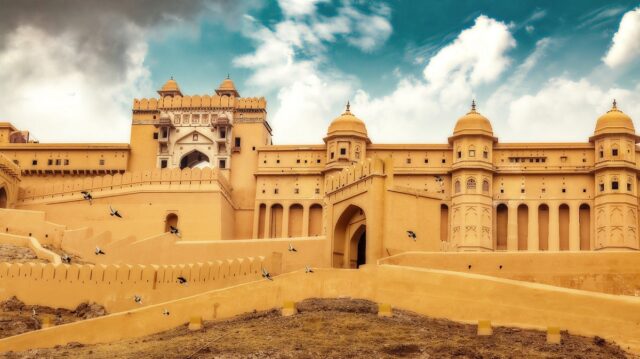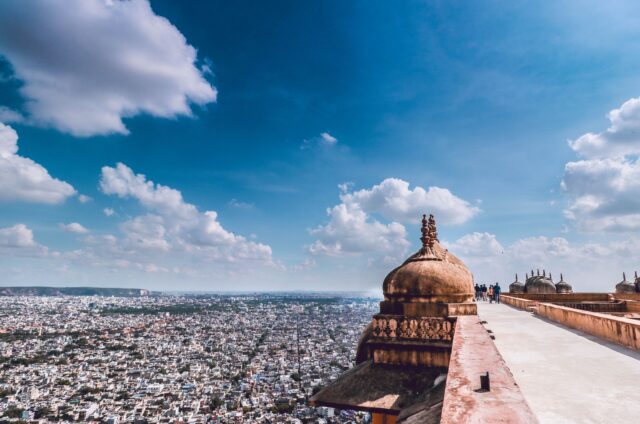Day 01 Jaipur Airport – Hotel – Jaipur Local Sightseeing
Meal :- Dinner
Welcome to Jaipur !!! Once you arrive at Jaipur International Airport in Jaipur. Meet by our representative and transferred to hotel check-in to your room. After fresh-up start to visit Jaipur > Jaipur is also known as the Pink City due to the dominant colour scheme of its buildings. It is also known as the Paris.
Albert Hall Museum, Patrika Gate, Hawa Mahal, Jantar Mantar, Royal Gaitor, Royal City Palace, Jal Mahal > Khajana Mahal – the one of its kind museum in India dedicated of Gem’s – Jewelry situated in the Heart of Jaipur city. Back to hotel overnight stay at Jaipur.
Day 02 Jaipur Fort’s Sightseeing
Meal :- Breakfast + Dinner
After breakfast start to visit > Amber Fort is known for its artistic style elements. With its large ramparts and series of gates and cobbled paths, the fort overlook’s Maota Lake, which is the main source of the water for the amber palace.
Nahargarh Fort is one of the most magnificent fort’s situated one the edge of Aravali Hills in Jaipur. Nahargarh fort stands on the edge of the aravalli hills overlooking the city of Jaipur is the Indian state of Rajasthan.
Jaigarh Fort is situated on the promontory called the hill of Eagles of the Aravalli ranges. It overlook the Amber fort the Maotha Lake. Back to hotel overnight stay at Jaipur.
Tour ends with sweet memories at Jaipur:
*If you want to customize to your own preferences feel free to call as well

Amer Fort
Amer Fort, also known as Amber Fort, is a famous tourist destination located in Jaipur, Rajasthan, India. The fort was built in the 16th century by Raja Man Singh I and is now a UNESCO World Heritage Site.
The fort is known for its stunning architecture, which is a blend of Rajput and Mughal styles. It is made of red sandstone and white marble, and is perched on a hill overlooking the Maota Lake. The fort’s impressive ramparts, gateways, and courtyards are also a highlight.
Visitors can explore the fort’s numerous rooms and halls, including the Sheesh Mahal (Hall of Mirrors), which is decorated with intricate glasswork. The fort also contains several temples, such as the Kali Temple and the Ganesh Temple.

Nahargarh Fort
Nahargarh Fort is a popular tourist destination located in the Aravalli Hills, overlooking the city of Jaipur in Rajasthan, India. The fort was built in the 18th century by Maharaja Sawai Jai Singh II and is known for its stunning architecture, intricate carvings, and panoramic views of the surrounding landscape.
The fort is a popular spot for visitors to watch the sunset over the city, as it provides breathtaking views of the Jaipur skyline. In addition to its beautiful architecture and scenic vistas, the fort is also known for its rich history and cultural significance.
Nahargarh Fort was originally built as a defensive structure to protect the city of Jaipur from invading armies. Over the centuries, the fort has been used for a variety of purposes, including as a royal hunting lodge and as a summer retreat for the Maharajas of Jaipur.

Jaigarh Fort
Jaigarh Fort is a historic fort located in the Aravalli Range in Jaipur, Rajasthan, India. The fort was built in the early 18th century by Jai Singh II, the ruler of Jaipur, and is known for its impressive military architecture, stunning views, and fascinating history.
The fort was built to protect the Amer Fort and its palace complex, and was strategically positioned to overlook the surrounding landscape. The fort’s massive walls, watchtowers, and gates are a testament to its military importance.
Visitors to Jaigarh Fort can explore its many courtyards, gardens, and museums. The fort is also home to the world’s largest cannon on wheels, Jaivana, which was built in the 18th century and was never fired in battle.

Pink City
Pink City is a nickname for the city of Jaipur in Rajasthan, India. The city was founded in 1727 by Maharaja Sawai Jai Singh II and is known for its stunning architecture, rich history, and vibrant culture.
The nickname “Pink City” comes from the fact that many of the buildings in the old part of the city are painted pink, giving the city a distinctive and unique appearance. The pink color was originally chosen to welcome the visit of Prince Albert, the consort of Queen Victoria, in 1876.
The city is home to several famous landmarks, including the Hawa Mahal (Palace of the Winds), which is a beautiful five-story palace with intricate latticework and balconies, and the Jantar Mantar, which is a collection of astronomical instruments that were used to measure time, predict eclipses, and study the stars.

Galtaji
Galtaji is a temple complex located in the Aravalli Hills in Jaipur, Rajasthan, India. The complex is known for its stunning architecture, beautiful surroundings, and rich religious and cultural significance.
The complex is home to several temples and sacred water tanks, including the Galta Kund, which is a natural spring that is believed to have healing powers. Visitors can also explore the Sun Temple, which is an ancient temple dedicated to the Hindu Sun God, and the Hanuman Temple, which is dedicated to the Hindu deity Hanuman.
One of the most unique features of Galtaji is its large population of monkeys, which are considered to be sacred by the locals. Visitors can watch these playful animals as they roam around the temple complex and interact with each other.

Hawa Mahal
Hawa Mahal, also known as the Palace of Winds, is a famous palace located in the heart of Jaipur, Rajasthan, India. The palace was built in 1799 by Maharaja Sawai Pratap Singh and is known for its stunning architecture and intricate latticework.
The palace is made of pink and red sandstone and features five floors of intricate balconies, jharokhas, and windows that allow cool breeze to flow through the palace, giving it the name “Palace of Winds.” The palace was designed to allow royal women to observe the street life and processions without being seen by the public.
Visitors to Hawa Mahal can explore its many rooms and balconies, which offer stunning views of the city below. The palace also houses a small museum with exhibits on the history and culture of Jaipur.


